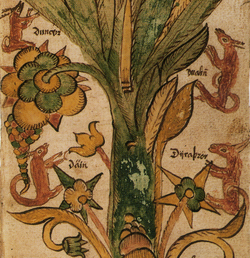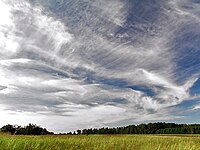
In Norse mythology, four stags or harts (male red deer) eat among the branches of the world tree Yggdrasill. According to the Poetic Edda, the stags crane their necks upward to chomp at the branches. The morning dew gathers in their horns and forms the rivers of the world. Their names are given as Dáinn, Dvalinn, Duneyrr and Duraþrór. An amount of speculation exists regarding the deer and their potential symbolic value.
Primary sources
The poem Grímnismál, a part of the Poetic Edda, is the only extant piece of Old Norse poetry to mention the stags.
1967 W. H. Auden & P. B. Taylor in The Elder Edda:
|
|
|
The second line is enigmatic. The word á is hard to explain in context and is sometimes omitted from editions. The word hæfingar is of uncertain meaning. Finnur Jónsson conjecturally translated it as "shoots". English translators have translated it as "the highest shoots" (Hollander), "summits" (Thorpe), "the highest twigs" (Bellows), "the high boughs" (Taylor and Auden) and "the highest boughs" (Larrington).
This verse of Grímnismál is preserved in two medieval manuscripts, Codex Regius (R) and AM 748 I 4to (A). The text and translations above mostly follow R, the older manuscript. Where R has the word hæfingar, A has the equally enigmatic hæfingiar. Where R has gnaga ("gnaw"), A has ganga ("walk"), usually regarded as an error. A third difference is that R has "ágaghálsir" in one word where A clearly has "á gaghálsir" in two words. In this case the A reading is usually accepted.
In the Gylfaginning part of Snorri Sturluson's Prose Edda the stanza from Grímnismál is summarized.
|
|
|
The word barr has been the cause of some confusion since it is most often applied to the needles of fir or pine trees. Richard Cleasby and Guðbrandur Vigfússon surmised that Snorri had used the word wrongly due to Icelandic unfamiliarity with trees. Others have drawn the conclusion that the World Tree was in fact a conifer. More recent opinion is that barr means foliage in general and that the conifer assumption is not warranted.
Theories


Early suggestions for interpretations of the stags included connecting them with the four elements, the four seasons, or the phases of the moon.
In his influential 1824 work, Finnur Magnússon suggested that the stags represented winds. Based on an interpretation of their names, he took Dáinn ("The Dead One") and Dvalinn ("The Unconscious One") to be calm winds, and Duneyrr ("Thundering in the Ear") and Duraþrór ("Thriving Slumber", perhaps referencing snoring) to be heavy winds. He interpreted the stags biting the leaves of the tree as winds tearing at clouds. He noted that dwarves control the winds (cf. Norðri, Suðri, Austri and Vestri, the dwarves of the cardinal points), and that two of the stag names, Dáinn and Dvalinn, are also dwarf names as well.
Many scholars, following Sophus Bugge, believe that stanzas 33 and 34 of Grímnismál are of a later origin than those surrounding them. Finnur Jónsson surmised that there was originally only one stag which had later been turned into four, probably one on each side. This is consistent with stanza 35 of Grímnismál, which mentions only one hart:
|
|
It has been suggested that this original stag is identical with Eikþyrnir, mentioned earlier in Grímnismál.
See also
- Anemoi
- Deer in mythology
- Four Heavenly Kings
- Four sons of Horus
- Guardians of the directions
- Lokapala
- Four Dwarves (Norse mythology)
- Titan (mythology)
Notes
- "Norse text, Ed. Helgason".
- "Grimnismál: The Lay of Grimnir" (Thorpe 1866, p. 24)
- Hollander 1962, p. 60.
- "hœfingar: brumknappar (merkíng óviss)", Jónsson 1905, p. 492
- "Conjecturally", Hollander 1962, p. 60
- "Highest twigs: a guess; the Mss. words are baffling. Something has apparently been lost from lines 3-4, but there is no clue as to its nature", Bellows 1923, p. 98
- Taylor & Auden 1969, Lay of Grimnir, strophe 33 given at http://www.germanicmythology.com/PoeticEdda/GRM33.html
- Larrington 1996, p. 56.
- "þeirs af hæfingar / gaghalsir gnaga", Jónsson 1905, p. 81.
- Lüning 1859, p. 176.
- Munch 1847, pp. 30 & 192.
- "Ed. Björnsson".
- "Trans. Brodeur". Archived from the original on 2004-01-16. Retrieved 2006-02-04.
- Byock 2005, p. 27.
- Cleasby, Richard; Vigfusson, Gudbrand. "BAENGOÐR -- BAUGR. 53". An Icelandic-English Dictionary. p. 53.
- "Together, bíta barr means to eat the foliage off a tree, words suitable for both an ash tree and a pine", Byock 2005, p. 140.
- "Efter Hjortenes Navne at dömme betegne Dáin og Dvalin (de sövndyssende, rolige) den milde og blide Vind; Dyneyrr (den dönelskende, dundrende) og Dyrathror (den dörstærke; som opsprænger Döre) derimod de heftige og stormende. Da Dvergene og raade for Vindene, have de to förste Hjorte fælles Navne med tvende af dem. Nogle forklare disse Hjorte for de 4 Elementer, eller og de 4 Aarstider, Maanens Phaser m. m.", Magnusen 1824, p. 144.
- "Stanzas 33-34 may well be interpolated, and are certainly in bad shape in the Mss. Bugge points out that they are probably of later origin than those surrounding them", Bellows 1923, p. 98.
- "The following two stanzas are very likely interpolations", Hollander 1962, p. 60.
- "Síðari hugmyndir eru það, að hjörturinn verður að 4 hjörtum, líklega einn við hverja hlið", Jónsson 1913, p. 22.
- "othing further is known of the four harts. It may be guessed, however, that they are a late multiplication of the single hart mentioned in stanza 26", Bellows 1923, p. 98.
References
- Bellows, Henry Adams (1923). The poetic Edda, translated from the Icelandic with an introduction and notes. New York: The American-Scandinavian Foundation.
- (Reprint: Princeton University Press, 1936 Sacred-texts)
- Brodeur, Arthur Gilchrist, trans. (1916). The Prose Edda by Snorri Sturluson. New York: The American-Scandinavian Foundation.
- Byock, Jesse, trans. (2005). Snorri Sturluson: The Prose Edda. Penguin. ISBN 0-14-044755-5.
- Björnsson, Eysteinn, ed. (2005). "Snorra-Edda: Formáli & Gylfaginning : Textar fjögurra meginhandrita". Archived from the original on 2008-06-11. Retrieved 2005-08-11.
- Magnusen, Finn (1824). Eddalæren og dens Oprindelse. Copenhagen: Gyldendal – via Internet Archive.
- Jónsson, Finnur, ed. (1905). Sæmundar-Edda : Eddukvæði. Reykjavík.
- Jónsson, Finnur (1913). Goðafræði Norðmanna og Íslendinga : Eftir heimildum. Reykjavík: Hið íslenska bókmentafjelag.
- Hollander, Lee M. (1962). The Poetic Edda. Austin: University of Texas. ISBN 0-292-76499-5.
- Helgason, Jón, ed. (1955). Eddadigte. (3 vols). København: Munksgaard. Text of Grímnismál available online at http://www.snerpa.is/net/kvaedi/grimnir.htm
- Larrington, Carolyne, trans. (1996). The Poetic Edda. Oxford World's Classics. ISBN 0-19-283946-2.
- Lüning, Hermann (1859). Die Edda : eine Sammlung altnordischer Götter- und Heldenlieder. Zürich: Meyer & Zeller.
- Munch, P. A., ed. (1847). Den ældre Edda. Christiania.
- Taylor, Paul Beekman; Auden, W. H. (1969). The Elder Edda: a selection. London: Faber.
- Thorpe, Benjamin, trans. (1866). Edda Sæmundar Hinns Frôða: The Edda of Sæmund the Learned. Vol. 1. London: Trübner & Co. pp. 19–27.
| The cosmological tree Yggdrasil and its inhabitants in Norse mythology | |||||||
|---|---|---|---|---|---|---|---|
| Inhabitants |
|  | |||||
| Roots reaching to |
| ||||||
| See also | |||||||